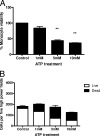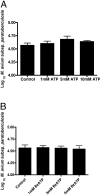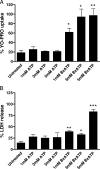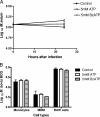Extracellular ATP is cytotoxic to mononuclear phagocytes but does not induce killing of intracellular Mycobacterium avium subsp. paratuberculosis
- PMID: 17634511
- PMCID: PMC2043304
- DOI: 10.1128/CVI.00166-07
Extracellular ATP is cytotoxic to mononuclear phagocytes but does not induce killing of intracellular Mycobacterium avium subsp. paratuberculosis
Abstract
Mycobacterium avium subsp. paratuberculosis is the etiologic agent of Johne's disease, a chronic granulomatous enteritis in ruminants. ATP has been reported to induce cell death of macrophages and killing of Mycobacterium species in human and murine macrophages. In this study we investigated the short-term effect of ATP on the viability of M. avium subsp. paratuberculosis-infected bovine mononuclear phagocytes and the bacilli within them. Addition of 5 mM ATP to M. avium subsp. paratuberculosis-infected bovine monocytes resulted in 50% cytotoxicity of bovine monocytes at 24 h. Addition of 2'(3')-O-(4-benzoylbenzoyl) ATP triethylammonium salt (Bz-ATP), which is a longer-lived ATP homologue and purinergic receptor agonist, significantly increased the uptake of YO-PRO, which is a marker for membrane pore activation by P2X receptors. Addition of Bz-ATP also stimulated lactate dehydrogenase release and caspase-3 activity in infected bovine monocytes. Neither ATP nor Bz-ATP reduced the survival of M. avium subsp. paratuberculosis in bovine mononuclear phagocytes. Likewise, addition of ATP or Bz-ATP was cytotoxic to murine macrophage cell lines (RAW 264.7 and J774A.1 cells) but did not affect the intracellular survival of M. avium subsp. paratuberculosis, nor were the numbers of viable Mycobacterium avium subsp. avium or Mycobacterium bovis BCG cells altered in bovine mononuclear phagocytes or J774A.1 cells following ATP or Bz-ATP treatment. These data suggest that extracellular ATP does not induce the killing of intracellular M. avium subsp. paratuberculosis in bovine mononuclear phagocytes.
Figures






References
-
- Aga, M., C. J. Johnson, A. P. Hart, A. G. Guadarrama, M. Suresh, J. Svaren, P. J. Bertics, and B. J. Darien. 2002. Modulation of monocyte signaling and pore formation in response to agonists of the nucleotide receptor P2X(7). J. Leukoc. Biol. 72222-232. - PubMed
-
- Apasov, S. G., M. Koshiba, T. M. Chused, and M. V. Sitkovsky. 1997. Effects of extracellular ATP and adenosine on different thymocyte subsets: possible role of ATP-gated channels and G protein-coupled purinergic receptor. J. Immunol. 1585095-5105. - PubMed
-
- Buell, G., A. D. Michel, C. Lewis, G. Collo, P. P. Humphrey, and A. Surprenant. 1996. P2X1 receptor activation in HL60 cells. Blood 872659-2664. - PubMed
-
- Chacon, O., L. E. Bermudez, and R. G. Barletta. 2004. Johne's disease, inflammatory bowel disease, and Mycobacterium paratuberculosis. Annu. Rev. Microbiol. 58329-363. - PubMed
-
- Chiozzi, P., M. Murgia, S. Falzoni, D. Ferrari, and F. Di Virgilio. 1996. Role of the purinergic P2Z receptor in spontaneous cell death in J774 macrophage cultures. Biochem. Biophys. Res. Commun. 218176-181. - PubMed
Publication types
MeSH terms
Substances
LinkOut - more resources
Full Text Sources
Other Literature Sources
Research Materials

